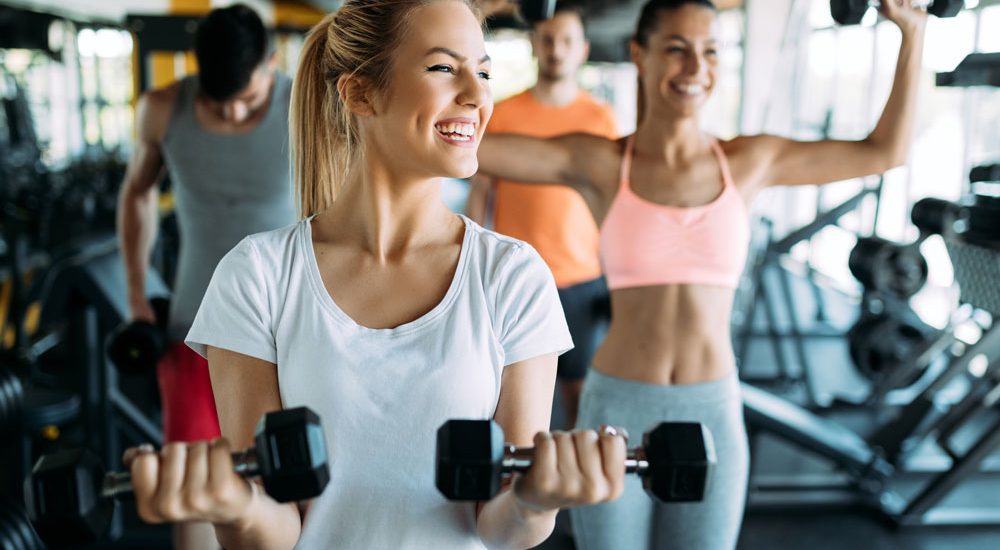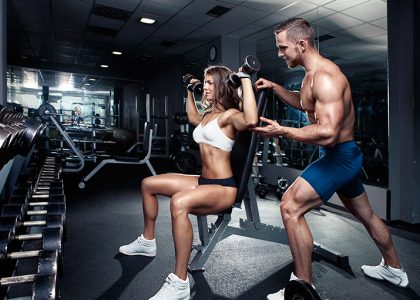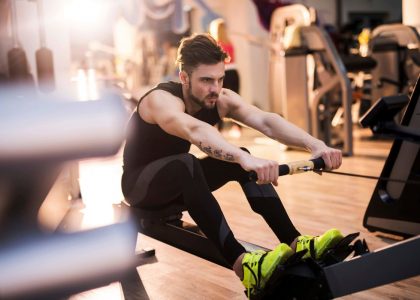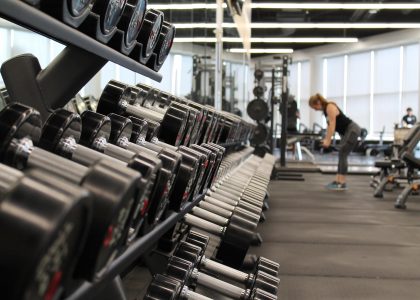A full body workout uses as many muscle groups in your body as possible within one training session. This gives you an unfair time advantage over other forms of training.
In this article you will learn which bodyweight exercises I recommend for a full body workout.
Let’s start your training!
Full-body training explained in a nutshell
I am a huge advocate of full-body exercise because it saves me time and is unbeatable when it comes to general fitness. In bodyweight training it is generally the preferred variant.
You will also notice this in my free training plans, which also mostly work with full body routines.
It only makes sense to think about alternatives if you want to strengthen certain muscle groups in a targeted manner or if you are a much more advanced user and want to pack more training units into the week.
That would be partial body workouts – also called split routines.
Split training as an alternative
There are various standard splits here that I would like to briefly introduce to you:
- Push / Pull
- upper body / lower body
- Push / Pull / Legs
Split routines are superior to whole-body training, especially in terms of recovery time (usually more time between training a certain muscle group) and focus on certain muscle groups.
There you can also incorporate exercises that better meet your special needs. Assuming your main goal is to have big biceps, split routines are probably better for you than full body workouts.
Even very advanced athletes can break through plateaus even better with split routines in one or the other exercise and so keep improving.
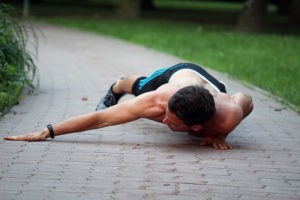
The Archer Push Up can be a great pressure exercise for advanced full-body training, but it also fits well into the push day of a split routine.
Using the example of the split routine push / pull / legs explained:
You divide your exercises into a push day (pressing exercises such as pushups, dips, etc.), pull day (pull exercises such as pull-ups, reverse bench press, etc.) and leg days (leg muscles such as squats, buttocks, lunge, etc.).
This is also called a 3-way split. You can then repeat these training units a second time a week and you would get 6 units. Or 4 units are enough for you and you want to specifically strengthen your pulling muscles and include a second pull day. Training on 5 days in the form of push / pull / leg break push / pull break is also popular.
Benefits of full body training routines
As far as the training time and the amount of training are concerned, full-body training plans are clearly ahead.
Let me explain this with an example.
With a split routine, you typically get two workouts per muscle group per week. For full body training on 3 trainings. That adds up to over 50 more workouts for a certain muscle group per year, which will also give you faster progress with this exercise or muscle group.
However, there are natural limits here: With a split routine you can, for example, accommodate a good 6 training units per week, but doing full-body training 6 times a week is not a good idea due to a lack of regeneration.
Especially for beginners, but also for advanced users, full-body training is my first recommendation. I also rely on it in my training!
It is also important to know that your full body workout should always include exercises from the following categories:
- Pressure exercises for the upper body
- Pulling exercises for the upper body
- Leg exercises
- Core and back exercises
- Extra: cardio exercise
Of course, running – especially fast runs and sprints – can be a great whole body workout.
Primarily, however, in this article I am going to focus on the strength components of full-body training, although I will also introduce you to an endurance exercise.
I present mobility exercises to you here.
6 bodyweight exercises that I recommend for full-body workouts
Squat
Stressed muscles: You mainly train your front thighs (M. quadriceps femoris), your buttocks (M. gluteus maximus), your thighs (sciocrural muscles) and your back extensor (M. erector spinae).The squat should really not be missing in any training plan. If done correctly, it is almost indispensable.
Correct technique: Stand about shoulder width apart. Your feet can be turned slightly outwards.
Make sure that the sole of your foot is always completely on the ground (imagine three points – two for your toes, one for your heel – that should stay on the ground) and bring your knees forward towards your toes (they may also protrude a little over your toes). Make sure that your upper body remains upright and stretched. You can use your arms as a counterweight in front of your body.
Frequent mistakes: You are not going deep enough (with the half squat 90 °, with the deep squat the upper and lower legs touch each other), your feet are turned out too far, the soles of the feet do not touch completely the floor, you are not squatting with the full range of motion, your standing position is too wide or too tight, your knees fall inward and your upper body does not stay upright. Here you can find more information about the correct technique for the squat.
Required equipment: Possibly. Armchair
Push-ups
The classic among bodyweight training exercises.
Stressed muscles: You mainly train the back of your upper arm (triceps brachii muscle) and chest muscles (pectoralis muscle).
Correct technique: Place your hands about shoulder width apart and make sure that your upper arms and elbows are close to your body.But the stabilizing muscles of your body are also working at full speed when you are in one of the push-up positions.
Then bend your arms so that your chest touches the surface of your hands. Then fully extend your arms again.
Frequent mistakes: Working with momentum and spreading your arms too far outwards should be avoided.
Here are other common mistakes: Doing push-ups correctly – avoid these 6 common mistakes.
Required equipment: Wall, table, bench, possibly ball
Why not do the push-ups on the floor right away?
Because, in my experience, unfortunately, over 90% of the population cannot do it. So be honest with yourself, do the variants in the complete and correct range of motion (from fully bent to fully stretched, without compensatory movements) and you will quickly get better and maybe soon switch to the floor or even be able to raise your legs a little.
Reverse bench press
This exercise is a real insider tip!
It strengthens your back, helps you maintain an upright posture, counteracts muscle imbalances by sitting a lot and prepares you for the pull-up that most people do not yet master at the beginning.
Correct technique: You may be familiar with the classic gym bench press. Well, in this exercise you don’t push, but – it’s the other way around – you pull yourself up to the bar, or in our case to the table.
Muscles under stress: You mainly train the front of your upper arm (M. biceps brachii and brachialis), your trapezius muscle (M. trapezius) and your broad back muscle (M. latissimus dorsi).
Make sure that you use the full range of motion and that your wrists are as in line with your forearms as possible.
Common mistakes: Half repetitions (i.e. don’t go all the way down), sagging of the upper body, etc.
Required equipment: stable table
You will love this exercise!
If you don’t have a stable table, everything else that you can hang yourself under will do (for example, two sturdy chairs and a solid wood broom).
Bridge
The bridge is not for the faint of heart. However, regular training definitely pays off in order to go through life with a strong back. With this variant you don’t have to.
Stressed muscles: You mainly train your back muscles (especially M. erector spinae), but also your legs and upper arms (M. triceps brachi).
Correct technique: The level of exercise shown here is about bringing your upper body and legs into line. So you sit in the long seat, support your stretched arms behind you and then push your buttocks up until you are stretched (as in the picture).
Frequent mistakes: Glute muscles not tense enough and therefore sag (no stretching of legs and upper body).
Required equipment: mat
The straight bridge is a preliminary exercise to the correct bridge. With a good bridge you can then do a lot of cool exercises. Later, when you’re really good at it, you can go up a wall with your hands, for example, or slide into the bridge from a standing position.
Leg lifters
Stressed muscles: You mainly train your hip flexors (M. psoas major) and your abdominal muscles (especially M. rectus abdominis), but also your front thighs.For me the leg lift is the abdominal exercise par excellence in bodyweight training because you can also increase it progressively in an optimal way. To start with, we will learn how to use the leg lifter while lying down with your legs straight and arm support.
Correct technique: Lie on your back on the floor and keep your feet close together. Lift your legs up, making sure that your lower back stays in a neutral position. There should be some space underneath, but no hand should fit underneath. If you put your hands under your buttocks, the exercise will be a little easier. At the beginning you don’t have to stretch your legs all the way, this also makes the exercise a bit easier.
Common mistakes: You hold your legs with the joints of your spine (sagging / hollow back)
Required equipment: mat, possibly pull-up bar (for advanced users)
If you have mastered this exercise well, you can remove your hands under your buttocks or hang on a pull-up bar and try the hanging leg lifter (you then lift your legs at least horizontally).
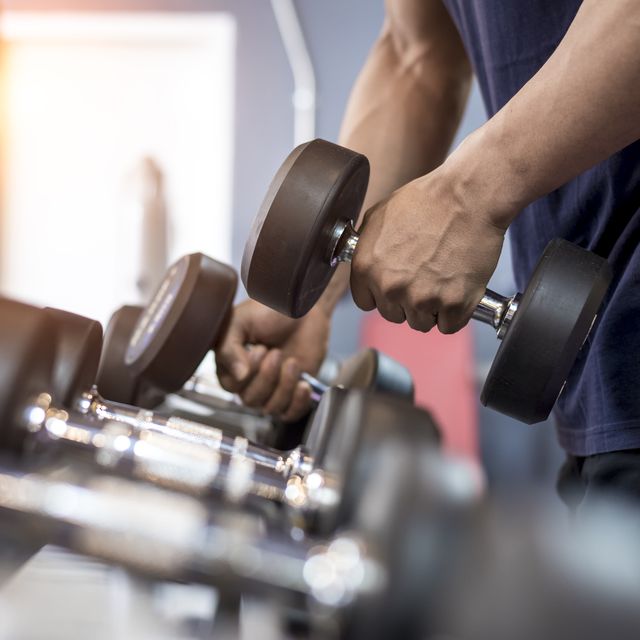
Squat jump
The squat-stretch jump with push-ups is better known under the name Burpee.
Since the burpee overwhelms most people at the beginning due to its intensity for the cardiovascular system, I would like to recommend a slightly simpler variant of it to you. This is also called a sprawl. Here is a video about it.
Stressed muscles: You train your whole body with it. Since it is not a specific strength exercise, it has more of an effect on your cardiovascular system and thus your endurance.
Correct technique: You crouch from a standing position, place your hands next to you and jump backwards into the support. Then you jump straight back into a crouch and then perform a stretch jump until you are back in the starting position and start the next repetition.
Frequent mistakes: Shoulders and core not tense, a variant that is too difficult is chosen, the whole foot is not put down (please do not just jump around on your toes!).
Required equipment: Mat if required
This exercise is a cardio exercise.
That means you don’t have to switch to a more difficult variant if you can do a certain number of repetitions without a break. Because it’s primarily about making you sweat. You can do that with this exercise, for example, with training methods such as Tabata, i.e. HIIT (high-intensity interval training).
For me, it is part of a full-body training plan because you can use it to train your endurance capabilities.
Conclusion
In this article you have learned the advantages of full body training and how you can do it with just a few exercises and without additional equipment.
In my bodyweight training complete package P.A.T. Bodyweight Training you will find many other exercises and also more difficult and easier variants of the exercises presented here. Especially with the first 5 exercises you should switch to a more difficult variant, at the latest when you can manage more than 15 repetitions at a time, in order to be able to get stronger.
If you can do less than 5 repetitions, however, it would be more advisable to find an easier level of exercise.
Here again the 6 exercises presented here in quick succession:
- Squat
- Push-ups
- Reverse bench press
- Straight bridge
- Leg lifter
- Sprawl (squat jump)



